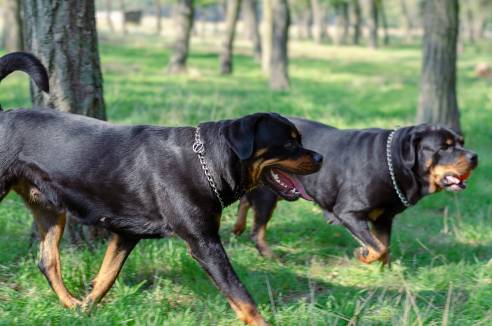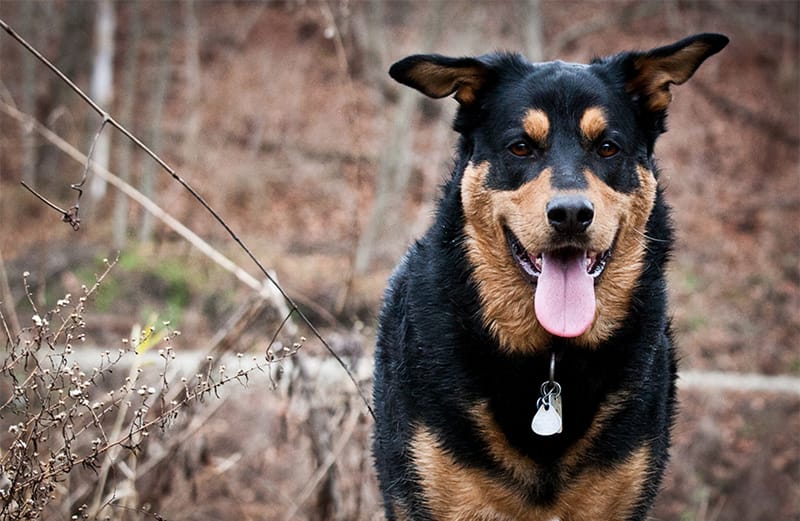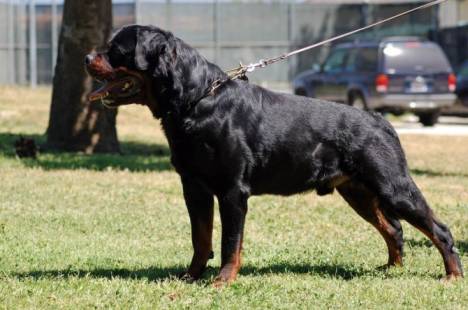Connect with a verified veterinarian in minutes. Licensed vets are available 24/7 to answer your questions. No need to worry about your furry family member.
Rottweilers are popular dogs; however, many people view them as highly aggressive dogs that are great as watchdogs. However, Rottweilers are so much more than that!
Did you know there are different types of Rottweilers? If not, you’re not alone! Pet parents are surprised to learn there are three types of Rottweilers. But are they similar or different from one another?
We’ve put together information about the three types of Rottweilers and details about each one. Let’s get started!
Three Different Types of Rottweilers
Officially, the AKC recognizes one Rottweiler dog breed; however, there are different types of Rotties within this one breed! That’s pretty confusing; we understand. But it’s important to understand these different types are all the same breed, rather than three separate dog breeds.
The main distinction is where the Rottweilers have been bred. Rotties coming from different countries can have different traits. The main reason is that breeding practices and standards differ between the countries.
For instance, Germany has much stricter breeding standards when it comes to physical traits, temperament, and genetic health. However, in the US, the dogs bred from two Rottie parents can be certified as purebred, which can lead to more variations in the dog breed.
So, there aren’t three different breeds of Rottweilers, but there are three different types of Rotties within this one dog breed. It just depends on where the dog was bred!
Three Types of Rottweilers
1. German Rottwieler
The history of the German Rottweiler isn’t certain. It’s thought the dogs may have come from a drover dog that was native to Rome. What is certain is that the dogs were bred to be working dogs. They’re full of energy and love to do any task they’re asked to do.
German Rotties are large dogs that can weigh between 77 to 130 lbs and stand between 25 to 27 inches tall. The dog’s life expectancy is about 10 years.
Appearance
When it comes to the German Rottweilers appearance, they have thick bones, broad bodies, with block-like heads. The dogs are bred according to the standard of the ancient Rottweilers.
The dogs’ eyes are similar to the American Rottie, with almond-shaped eyes that are dark. The dogs sport broad, triangular ears that strongly resemble the American Rottie.
However, the German Rottweiler’s body is larger than American Rottweilers. They have a muscular chest and well-formed ribs. The tail is usually left to grow naturally, as tail docking is not allowed for German Rotties. In addition, the dogs have a double coat, with the topcoat medium-length and rough, with a softer undercoat.
Temperament
What about temperament? German Rotties are loyal and committed to their pet parents. They’re also highly intelligent, patient, and eager to please. They make wonderful work, service, police, and therapy dogs. When properly trained, they get along great with kids and other dogs. And they are very protective of their family.
These are strong dogs that need consistent training, socialization, and daily exercise to help them know how to behave.
2. American Rottweiler
Like the German Rottweiler, the American Rottweilers ancestors go back to the Roman Empire. The Romans bred the dogs to help herd cattle. American Rottweilers were originally brought over from Germany; however, today, they’re bred in the US.
American Rotties are used as working dogs to pull carts, do police work, and herd cattle. They have a muscular build and a will to work that makes them great for a wide variety of jobs.
Appearance
The American Rottie is a medium-sized dog that has a muscular build. They’re usually black with rust markings. Males are usually larger than females; however, the females are still muscular and have a solid build.
The American Rottweiler usually has a docked tail. When it comes to their fur, the dogs have straight hair that’s rough, with a medium-length outer coat. The undercoat is usually on the thighs and neck.
Temperament
The American Rottweiler is affectionate, loyal, and protective. They make excellent watch dogs! While many view the dog as not very bright; however, the American Rottie is highly intelligent and calm. They also don’t live up to their reputation for being aggressive dogs.
These dogs are loving and want to play with their families. They are loving towards everyone in the family, including kids. However, they may be somewhat wary of strangers.
3. Roman Rottweiler
The Roman Rottweiler is a giant dog breed. They are known as one of the giant dog breeds on Earth. The Roman Rottie can stand between 23 to 30 inches tall and weigh between 85 to 130 lbs. The dogs have a life expectancy of about 14 years.
Appearance
Roman Rotties are usually black & tan or black & mahogany. They’re strong and muscular. They have a strong, broad head, including the upper and lower jaws.
Their eyes are also rounded and usually a deep brown color. Both jaws have large scissor-bite teeth. Like the German & American Rotties, the Roman Rottweiler has broad triangular ears. These dogs also have strong, curved necks.
Temperament
The Roman Rottie is a very affectionate, loving dog that’s very protective. They will do what’s necessary to keep their families safe. The dogs have a deep instinct to guard and protect that goes back to the breed’s ancient roots.
The dogs are highly intelligent and brave. They’re willing to learn and usually pretty easy to train. They’re eager to please, attentive, and usually submissive when being trained.
One of the downsides of the Roman Rottweiler is that the dogs have not been developed with standard breeding practices. They’ve been bred to be larger and heavier than other Rotties. The problem is this can lead to major health issues in these dogs. They may suffer from orthopedic problems, such as hip dysplasia and others. The dogs also overheat because they’re so large.
It’s important to note these dogs are not recognized by the AKC or the ADRK (German kennel organization). The reason for this is that the dogs are bred to be larger than the breed standard for both organizations.

Review symptoms, medications & behavior to keep your pets healthy with a Vet Online in just minutes.
Ask a Vet Live NowSumming It Up
As you can see, the main difference between the three types of Rottweilers is in their appearance and where they’ve been bred. In addition, the German Rottie’s tail is allowed to grow naturally, while the American Rottie’s tail is usually docked.
What’s more, the Roman Rottie is not recognized by the AKC or the ADRK. This is because the Roman Rottweiler is raised to be too large, which can lead to serious health issues. What’s more, these dogs may be a mix between a Mastiff and a Rottweiler, rather than a purebred Rottweiler.
So, if you’re looking to adopt a Rottie, be sure to check the type of Rottweiler the breeder’s offering. It’s best to steer clear of those offering “Roman” Rotties and instead choose a German or American Rottweiler.
Connect with a verified veterinarian in minutes. Licensed vets are available 24/7 to answer your questions. No need to worry about your furry family member.

Julie
Julie is a graduate of the University of North Carolina, Wilmington, where she studied Animal science. Though contrary to the opinion of her parents she was meant to study pharmacy, but she was in love with animals especially cats. Julie currently works in an animal research institute (NGO) in California and loves spending quality time with her little cat. She has the passion for making research about animals, how they survive, their way of life among others and publishes it. Julie is also happily married with two kids.
Review symptoms, medications & behavior to keep your pets healthy with a Vet Online in just minutes.
Ask a Vet Live Now




